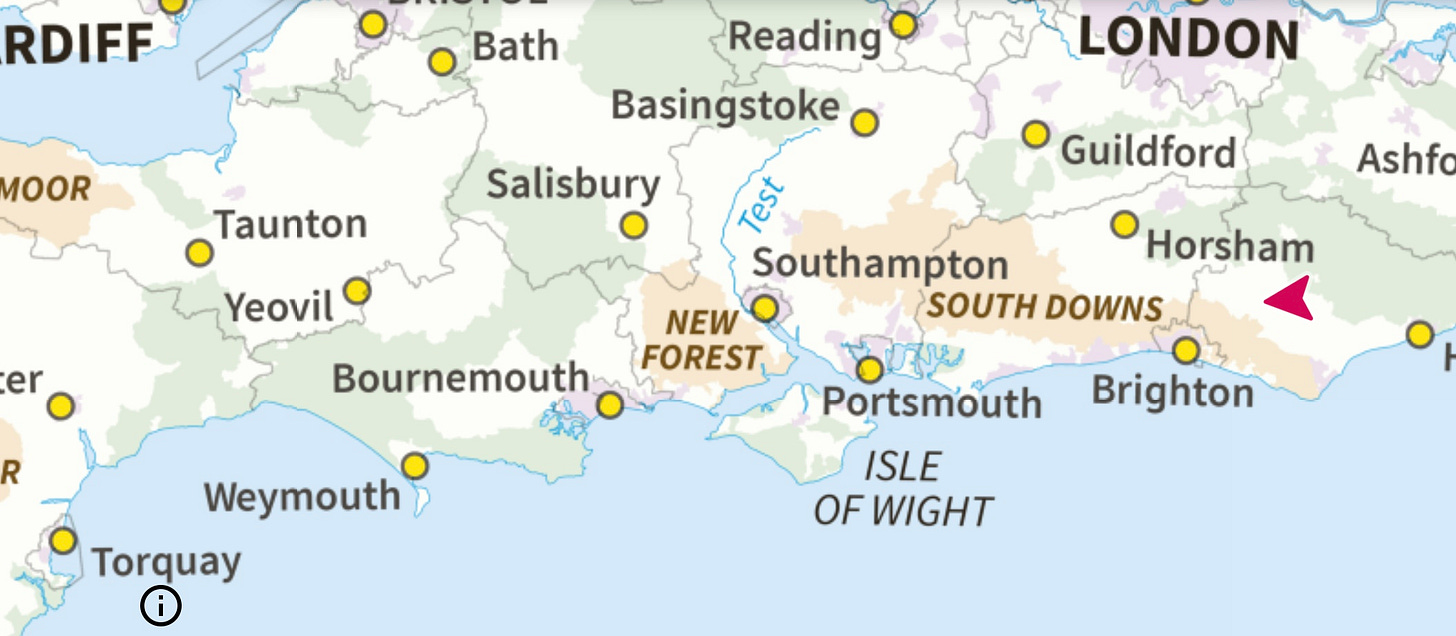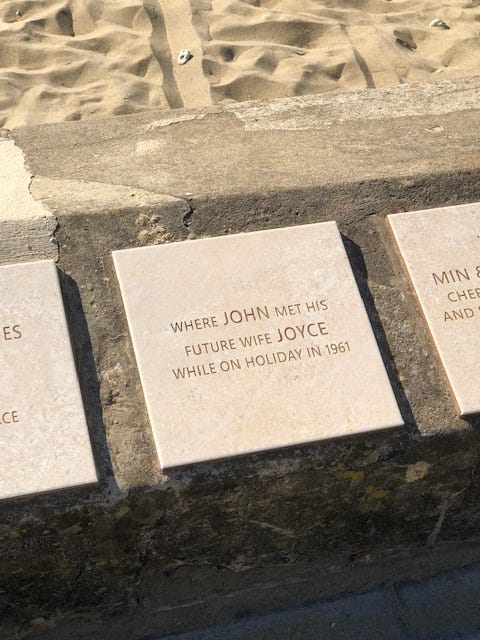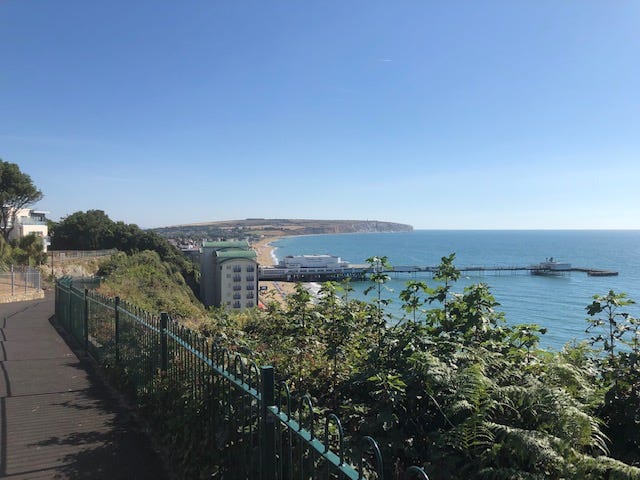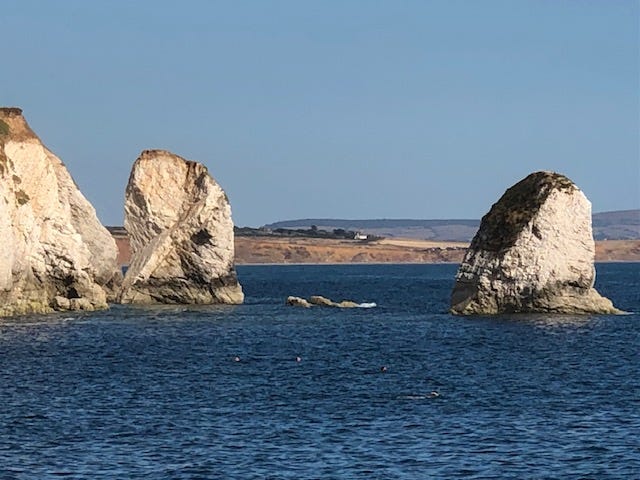18. The simple pleasures offered by a tiny island
Revisiting the endless summers of my childhood.

Dear Reader,
The Isle of Wight is the sort of island kingdom we drew as children. Not far from home, and with its entire northern coastline within sight of the mainland, this little island just off the south coast of England is perfect for a summer break and even more perfect for a future walking trip.
The place names are straight out of a children’s adventure story. In a book, Blackwater and Steephill Cove would be the hangouts of pirates or smugglers, with Freshwater and Seaview perhaps locations for the more wholesome characters of the piece.
I was a child when I first came to the island, my head full of the adventures of Enid Blyton1’s ‘Famous Five’ and ‘Secret Seven’. We’d stayed in a rented cottage with my grandparents in Seaview, its name so conspicuous as to be unlikely.
Let’s face it: Seaview is an obvious name for a village on the edge of a small island with 57 miles (92 kilometres) of coastline. I like to imagine all of the island’s first village elders tossing a coin over the shortlist of names to win the right to snag that one.
We were slap bang in the middle of the second long heatwave of the British summer. And although we were working on the first day of our two-day trip, I was desperate for any opportunity to cool off in the sea.
Every beach had a different substrate. In the shallows of the Solent just off Queen Victoria’s private beach at Osborne House2 I dug my feet into scratchy, chunky not-quite-sand-not-quite-gravel: a dreamy exfoliant worthy of a high-end spa.
Not far away, at Ryde, the fine sand was bright white, dry and billowy, and like at Osborne, the beach was streets apart from the lumpy shingle ones of our coastal resorts nearer to home.
Sandown’s packed sandy beaches on the south-eastern edge of the horizontal rhombus of the island were filled with rent-by-the-day sun loungers and parasols. Coaches struggled to offload their tourist passengers in the narrow streets crowded with badly-parked cars. On the pavement a small huddle of coach drivers complained about the traffic, gulping chilled water from dripping bottles.
Near to the war memorial on the seafront a long line of engraved plaques caught my attention.
Here were shown a whole gamut of feelings: romantic, thought-provoking, poignant and amusing.
SANDOWN SWEETHEARTS
FRANK & JOAN
MET HERE 1957
CELEBRATING
60 YEARS OF MARRIAGE
2019
This one made me laugh:
‘EVERY LITTLE HELPS’
SAID THE OLD LADY
AS SHE WEED IN THE SEA
(Not a bad idea, given that the Isle of Wight has been subject to a hosepipe ban since the first Friday in August.)
My favourite plaque of all asked – and answered:
HOW LUCKY ARE WE…?
WE’VE GOT ALL OF THIS!
Further along the beach I noticed a sign with a word I didn’t know.
‘Welcome to Sandown-Shanklin Revetment’
An inspection of what appeared beyond the sign suggested the revetment3 to be a sea wall built up from the beach, and a quick Google search backed this up, telling me that its job was to protect the base of the cliff from erosion.
Providing two miles of flat pavement, the revetment’s broad tarmacadam top is a shared route for walkers and cyclists between Sandown and Shanklin populated by cafés, ice cream kiosks and beach huts.
‘I wonder if the Coastal Path will take you along there?’ My husband held my gaze for a suspiciously long time. I didn’t want to commit to an answer. How did he know this was my plan?
‘I hope not! It looks boiling!’ This would not be the route I’d want for a long-distance walk in a heatwave, the sun beating down and then reflecting off chalk cliffs, hard landscaping, white sand and the blazing mirror of the sea.
‘No, it’s up there: look!’ There was the sign. Leaving him behind, I climbed the hill to the top of the cliff and waved from the top. Here was better. I could do this. Well away from the sticky bustle of noisy tourists and their ice creams this path was a peaceful haven with far-reaching views. Yes, I would walk the island. Right there I decided to plan my future trip, but for a cooler time of year.
After the bucket-and-spade rough and tumble of Sandown we took a drive down the coast to Compton Bay on the western edge of the island. The clifftop car park, free for us as National Trust members, had plenty of choice for spaces, and we were drawn to a cluster of campervans and motorhomes towards the edge overlooking the beach. We drew up alongside a fellow VW Transporter, nodding at our smiling neighbours relaxing in their lounge chairs.
The great thing about going to the beach in a campervan is that you’ve got everything to hand: chilled drinks, lunch, hooks for towels, privacy to change into and out of swimwear, and of course our own ‘facilities’ in the form of a PortaPotti in its own underseat locker. Reader, we were kings!
Leaving the van to enjoy its view across to the Dorset coast we scampered like children down the cliff steps to the sandy beach below. It was high tide, and tiny fish were darting over the rippled sea floor. I envied other swimmers with their masks and snorkels: the beautifully clear sea covered interesting rock formations and even the wreck of a boat, and with the right tools there would have been plenty of marine life to see. I vowed to pack some goggles next time.
The cliffs were extraordinary: diagonal striped orange and terracotta on one side of the beach gave way to the more familiar white chalk on the other. Later, as the tide receded, we saw corresponding diagonal bands of rock stretching out into the sea.
With no ice cream van at Compton Bay, Freshwater was our next stop for a cooling treat. There was no sand here at all, just a steep beach of grey shingle leading to deep-in-three-steps water. Two girls sharing a paddleboard shrieked as they took it in turns to stand and to kneel, the board floating empty every time they both fell in at once.
A young dad with a baby in a pushchair passed us on the prom as we enjoyed our ice creams. Two tiny boys were in hot pursuit, wielding too-big-for-them litter pickers and grabbing every piece of rubbish, however small, that their pincers could get hold of. Their squealing excitement was off the scale.
‘Wow, they’re keen!’ my husband commented. Later, on the way back to the van, we saw this sign. This is where the boys had started! We liked to think that this late-afternoon litter pick was their family ritual.
Three bigger boys were doing whatever they could to avoid helping their parents pack up their beach camp. Mum and Dad struggled to roll up windbreaks and stow sopping towels into an overflowing beach bag while their sons sledged from the top of the steep beach all the way down towards the sea, their body boards temporary toboggans for the twenty seconds it took them to reach the water.
Forty – and more – years ago every summer had felt like this: hot and sunny with no rain for weeks, happy days filled with walks, ice creams and swims in the sea seeming to stretch on forever. For these two days on this tiny island I was a child again.
Love,
Rebecca
If you enjoyed this post, please let me know by clicking the heart. Thank you!
Of course, although I don’t remember rain on those long summer holidays I’m sure it happened often! What were the summers like when you were a child?
Thank you for reading! If you enjoy ‘Dear Reader, I’m lost’, please share and subscribe for free.
Enid Mary Blyton (11 August 1897 – 28 November 1968) was an English children’s writer, whose books have been worldwide bestsellers since the 1930s, selling more than 600 million copies. Her books are still enormously popular and have been translated into 90 languages. As of June 2019, Blyton held 4th place for the most translated author. She wrote on a wide range of topics, including education, natural history, fantasy, mystery, and biblical narratives. She is best remembered today for her Noddy, Famous Five, Secret Seven, the Five Find-Outers, and Malory Towers books, although she also wrote many others including the St Clare’s, The Naughtiest Girl and The Faraway Tree series.
Taken from Wikipedia
Osborne House is a former royal residence in East Cowes, Isle of Wight. The house was built between 1845 and 1851 for Queen Victoria and Prince Albert as a summer home and rural retreat. Albert designed the house himself, in the style of an Italian Renaissance palazzo.
Queen Victoria died at Osborne House on 22 January 1901.
Taken from Wikipedia
Revetments in stream restoration, river engineering or coastal engineering, are structures placed on banks or cliffs in such a way as to absorb the energy of incoming water. In military engineering they are sloped structures formed to secure an area from artillery, bombing, or stored explosives. River or coastal revetments are usually built to preserve the existing uses of the shoreline and to protect the slope, as a defense against erosion.
Taken from Wikipedia











I love the light on the Isle of Wight. Your pics do it much justice. I hired a bike there once, when I went on holiday with a friend. It was good, although I still think they should flatten out the hills, or at least only have them going down.
I hadn't really thought about the variety of beaches on the Island; what a great observation. Your photo on the Coastal path is along a section that we walk daily, and every day I feel blessed to live in such a gorgeous place.